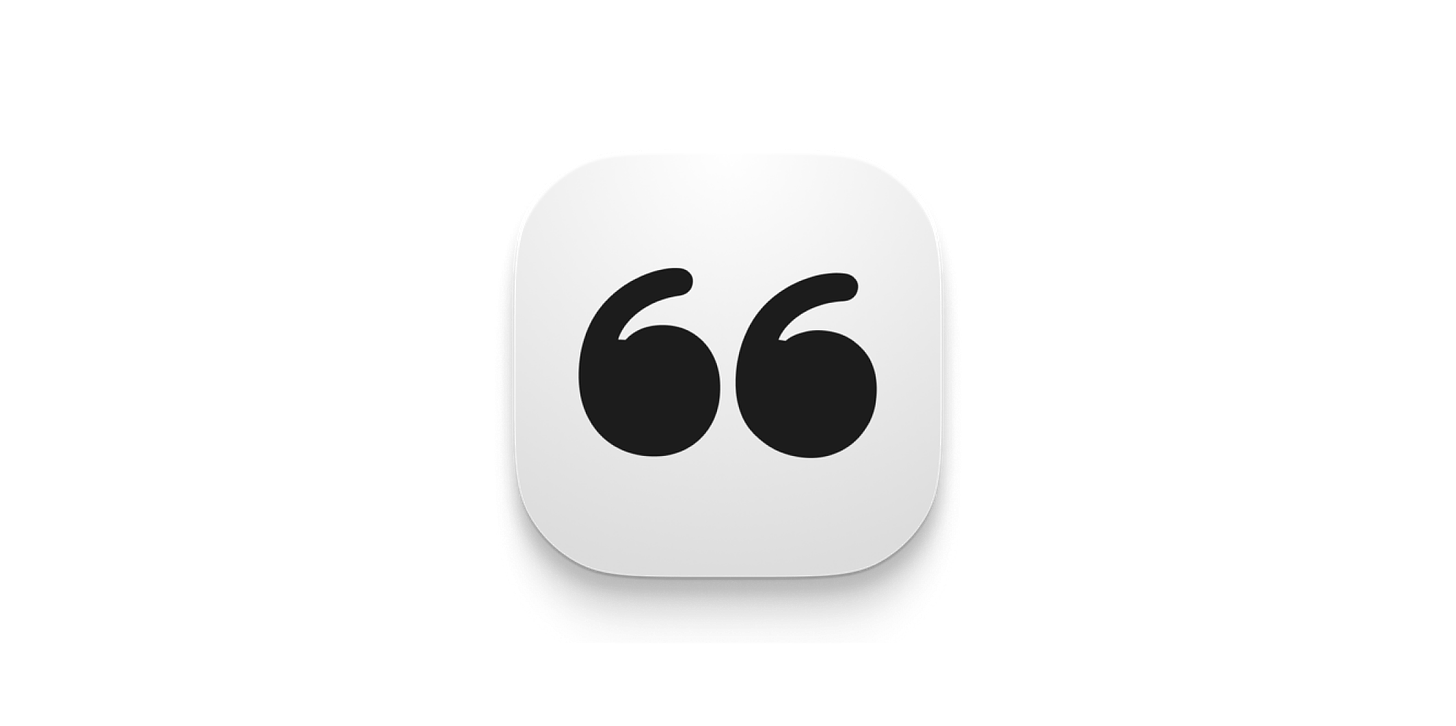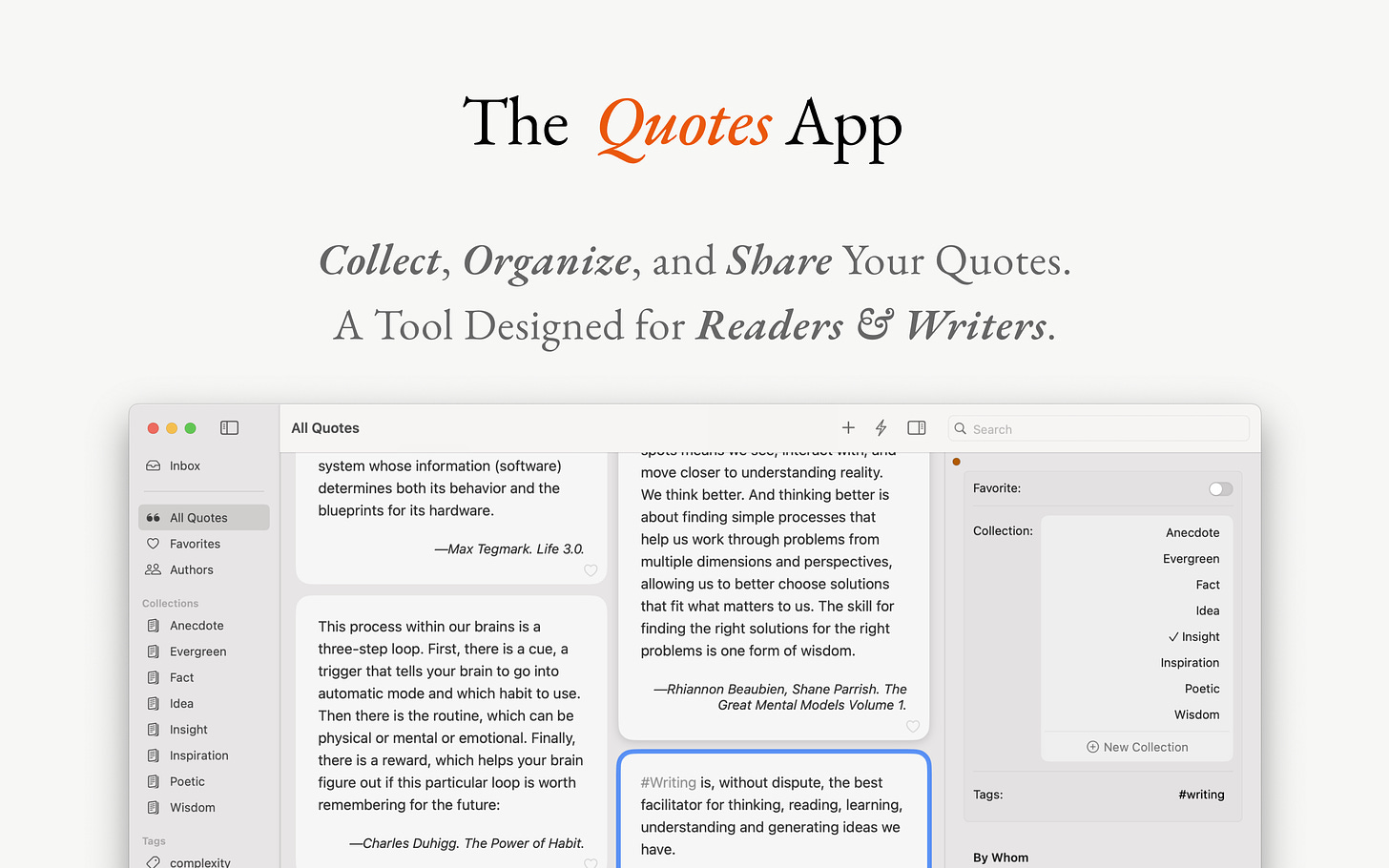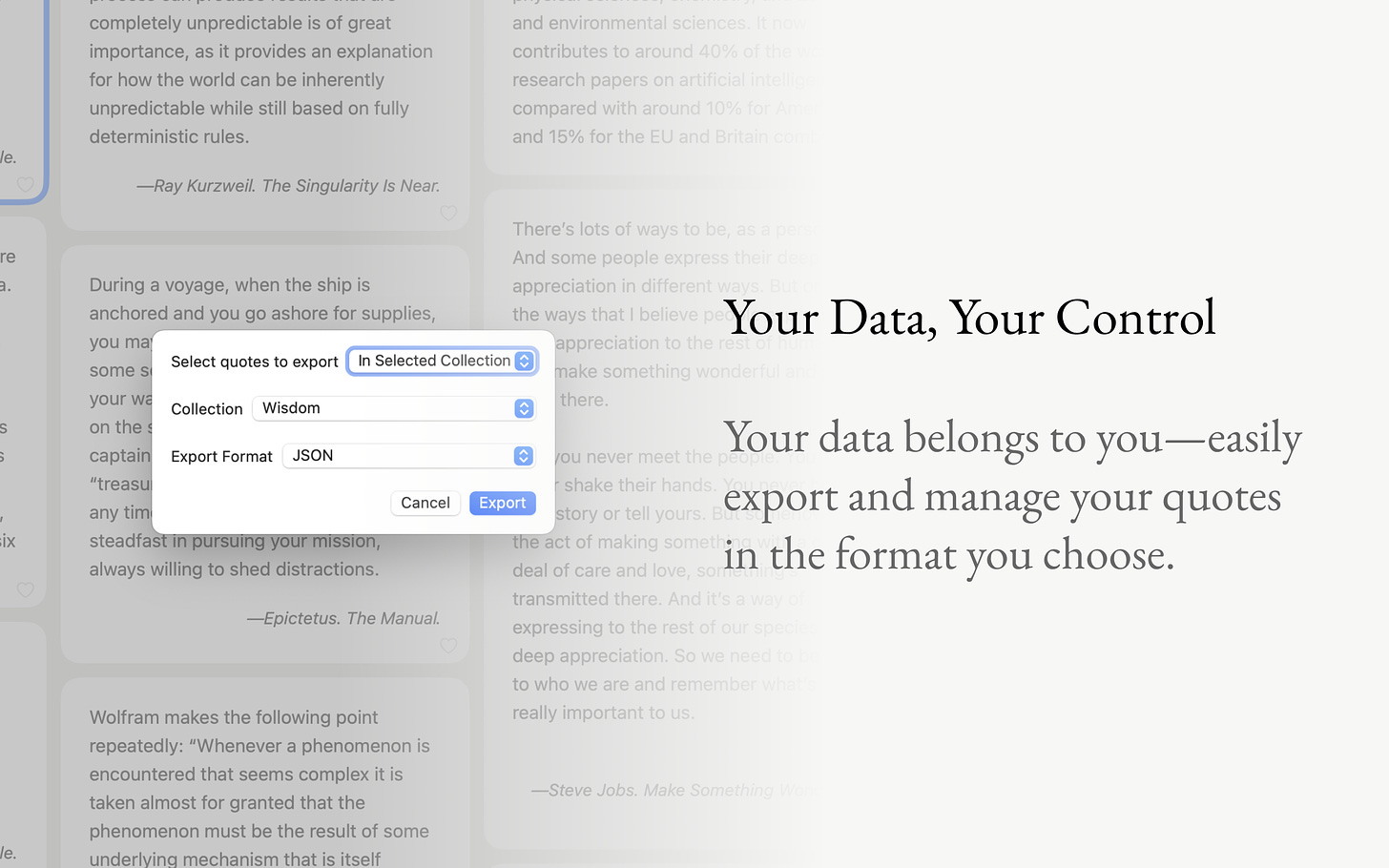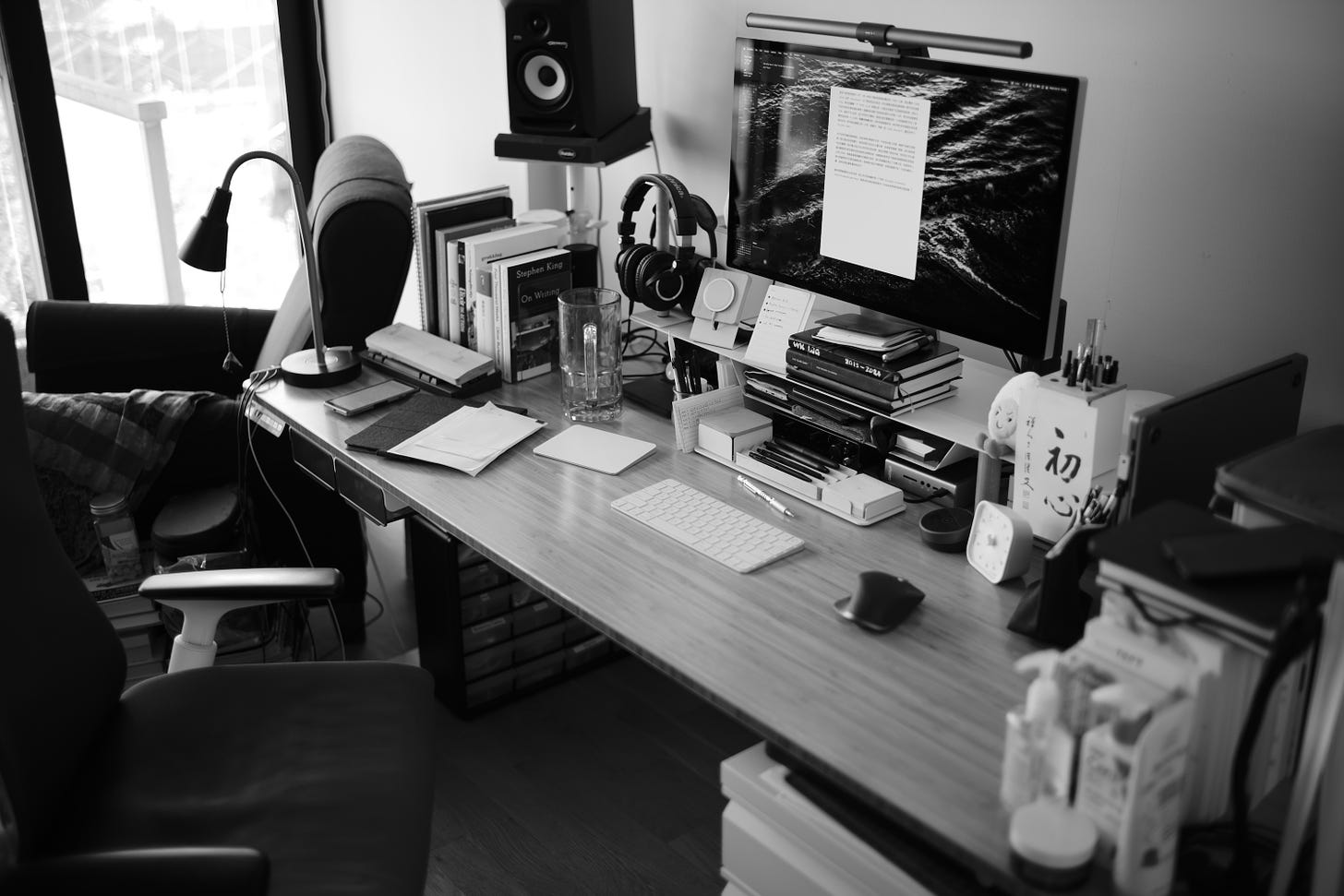Apptisan #027 — Talking with Quotes’s Creator: A Set of Tools for Readers and Creators, to Collect, Handle, Manage and Share Their Quotes
For our 27th edition, we’re thrilled to feature Conan, the founder of the newly established blurrr studio and creator of their debut product, Quotes
Name: Quotes
Developer / Team: blurrr studio
Platforms: macOS
Read this newsletter issue in Chinese (中文) .
Please describe your product.
Quotes is a simple tool, designed for people who love words. It’s like a note-taking app, but its focus is on collecting, organizing, savoring, and sharing text.
With one of the features Quick Capture, you can instantly save quotes the moment they touch you, simply by pressing a hotkey. Later, you can revisit these moments and let the words sink in. If you work with words or enjoy organizing them, the Collection and Tag systems of Quotes help you neatly arrange each quote, making it easier to find them again in the future.
You can also use the Desktop Widget to display quotes that inspire or motivate you throughout the day, or set reminders to bring these powerful words back into your life when needed. And of course, part of the joy of reading is sharing what moves you. Quotes’ WYSIWYG (what you see is what you get) editor allows you to create beautiful quote images with just one click, perfect for sharing with family and friends or on social media.
Was there a pivotal moment that inspired your product’s creation?
I’ve always needed something like Quotes. I’ve loved reading and collecting quotes for as long as I can remember. And as a tech enthusiast, I was one of the early adopters of e-readers. Over time, my list of analog and digital quotes grew larger, and managing them became a real challenge. Some memorable conversations about this topic date back over a decade, when my friends and I talked about how to organize our quotes. That’s when I realized this need wasn’t just mine—many people feel the same way.
In the past decade, I looked for tools but never found one that fit my needs. During the time, I developed a command-line tool to organize my reading notes, but it wasn’t practical for most people. Though I promised my friends I would share the tool with them, it wasn’t until now, with Quotes, that I’ve truly fulfilled that promise.
What makes your product unique compared to others in the market?
Quotes focuses on doing one thing well: quotes. It’s not a general-purpose note-taking app. Its features are carefully designed for specific use cases, like reading and excerpting. For example, to avoid disrupting your reading flow, Quotes has a one-hotkey capture feature. Rather than sending the quote directly to the library, it stores it in the Inbox so you can review it later. This avoids the mental load of deciding whether to keep a quote during the heat of reading. Once you’re done with the reading, you can open the Inbox and decide what to keep or discard. This is just one workflow, and you’ll find similar thoughtful touches throughout the app. Plus, Quotes will continue to grow, with even more features in future updates to fit different work styles.
Another key feature is that Quotes is a local-first, native app. This means you own the copy of the software and your data 100%. Unlike SaaS products that rely on external servers, Quotes works entirely on your device. Your data is stored locally, and when online, it syncs via iCloud—none of your data is accessible by anyone else, including me.
By being native, Quotes offers deep system integration and a smooth user experience. I’m a fan of finely-crafted apps like Things and iA Writer. They provide a seamless, delightful experience thanks to their native design and optimization for system resources. I committed to go with the native route for Quotes to achieve the same standard.
How have you marketed your product, and what key lessons have you learned?
Since Quotes is still in active development, I haven’t done much promotion—just one Reddit post. If you’re honest and transparent, people will respond in kind. This is how the online community works.
Most users have found the app through the App Store search. This has shown me that users who need a product like Quotes will actively search for solutions. Because of that, I believe App Store Optimization (ASO) is crucial, though I haven’t got the time to tackle it yet.
Moving forward, I plan to explore more strategies, such as Product Hunt, traditional ads, and perhaps submit to the App Store Editors Pick. And of course, more relevant subreddit groups.
What has been some memorable feedback since your product’s release?
Developing Quotes has revealed the kindness in the community of quote lovers. Even before any major promotion, users discovered Quotes in the App Store. Though Quotes is still using voluntary-paid plan at the moment, many users have not only purchased the app but also written me heartfelt emails, filled with enthusiasm and hope, wanting Quotes to succeed.
The first letter I received included a series of great suggestions, along with a heartfelt wish for Quotes to do well and even ideas for business models. Another memorable moment was a Reddit user initially saying the app was too expensive. After I shared my perspective, he/she agreed and purchased the app immediately, wanting to support its early development. It’s moments like these that make Quotes feel more like a community-driven project than just my own entrepreneurial venture.
Are there any products out there that you feel deserve more recognition?
Aside from the more well-known apps like Things and iA Writer, one app I really appreciate this year is One Thing, by prolific indie developer Sindre Sorhus. It’s incredibly simple: it displays a single customizable text line in your system menu bar. Every day while I work, I set it to show my key task for the day. Today, it reads, “Apptisan Interview.” It keeps me focused. The app is focused too—it does one thing and does it well. That’s a philosophy worth reflecting on.
Another tool I use is Velja, also by Sorhus. It’s almost an invisible app that lets you set rules for which browsers to open specific links. For example, I use Chrome for Google Meet and Safari for Apple. Sorhus’ tools are all hyper-focused, and I find them inspiring.
What are your primary hardware tools?
Discussing hardware often risks turning into consumerism, so I want to set some context first.
I prefer tools that naturally help me stay focused. Even if a tool isn’t inherently conducive to focus, I find ways to make it work for me. A good tool, in my view, should stay out of your way rather than demand your attention or disrupt your workflow. This mindset shapes how I choose my tools, and it also informs how I design Quotes.
I used to enjoy tinkering with gadgets and highly customizable systems. But over time, I’ve come to realize that a good tool is one that gets things done. It needs to be stable and durable, not just aesthetically pleasing or fun to use. My experience also tells me that while good tools are often expensive, not everything expensive is necessarily good. When choosing tools, I focus on their effectiveness, not their price tag.
Lastly, what qualifies as a “good” tool varies from person to person. In this context, “good” means something that meets specific needs. With that in mind, I’ll provide examples of what I use—because the editor asked for specifics—but be careful not to fall into the consumerism trap. Also, I’ll be selective to keep this response concise, so it won’t cover everything.
Daily Work:
Computer: MacBook Pro M1 Max (64GB) + Studio Display + Magic Keyboard + Magic Trackpad + Logitech MX Master 3S. The computer is the tool where I’m most prone to distractions, so I follow three rules:
Each desktop is reserved for one purpose. Switching between desktops wastes time and energy, so I’ve trained myself to minimize context switching. I once tried Later to save sessions for later use, but since it didn’t fully restore sessions, I stopped using it. However, the concept is the same: increase the cost of multitasking to discourage it. Similarly, I organize my browser tabs into different spaces to maintain focus.
I start every task by writing it down in One Thing, which helps me stay on track by reminding me of the current session’s purpose. I also use Timemator to automatically track my time in the background, making it easier to review later.
For reading and writing, I activate HazeOver to dim other windows and use OneSwitch to eliminate visual noise.
I also choose a laptop because it allows me to work outdoors or on the rooftop when the weather is nice.
Thinking, Note-taking, and To-dos: Various notebooks, sticky notes, and pens. I’m someone who needs to see ideas visually to think clearly, so I always keep paper and pens nearby.
Most of the time, I use my LEUCHTTURM1917 notebook for rough drafts and work notes, and when it’s time to break tasks down, I record them in Linear (for engineering tasks) or Things (for business-related tasks).
If I’m at my desk, I’ll write my top priorities for the day on a card and place it somewhere visible. Lately, I’ve been using Analog, but before that, I used sticky notes—the effect is the same.
When I’m out and about, I carry a Midori TRAVELER’S Notebook (passport size) for jotting down ideas and sketches.
As for pens, I prefer metal-bodied pens because they have a good weight, feel comfortable, and are durable. For work, I avoid fountain pens (although I do have a collection of them) because they can be unstable and a bit distracting. The pens I use most, in order of frequency, are the Ohto Super Promecha 0.5, rOtring 600 Ballpoint Pen, and Caran d’Ache BALL PEN 849.
Ergonomics and Office Safety: Fully Bamboo Standing Desk (they were acquired by Herman Miller in 2019), Embody Chair, yoga ball, anti-fatigue mat, and BenQ ScreenBar Halo. Since I spend long hours at my desk, investing in ergonomics is crucial to avoid injuries that might go unnoticed but are irreversible over time. I follow these rules for myself:
Spend 1/3 of the day standing. The anti-fatigue mat helps extend standing time.
Spend 1/3 of the day sitting on the yoga ball, which forces me to engage my core.
The remaining time can be spent sitting, but with proper posture. This is where the adjustable standing desk and ergonomic chair come into play.
Always keep the ScreenBar on auto mode to ensure the screen and environment are evenly lit.
Leisure and Entertainment:
Reading: Physical books, Kindle Voyage, Kindle Scribe, and Hisense TOUCH Lite. If possible, I prefer reading physical books, but for some bestsellers that aren’t worth collecting, I’ll use an e-reader or my computer. I use the Kindle Scribe mainly for reading papers. My favorite device, however, is the Hisense TOUCH Lite because it’s lightweight and perfect for extended reading sessions.
Music: I do use streaming services like Apple Music, but mainly to discover new music. For albums I love, I buy vinyl and digital versions. The digital files are for my iPod Classic (which I usually pair with Shure SE846 earphones). These two methods help me focus and truly appreciate the beauty of music.
Photography: Leica M6/M10, iPhone Pro, and iPad mini. I love photography because it gets me out of the office and trains me to notice beauty in everyday life. Developing an eye for beauty in photography helps me spot good and bad design in products, which is crucial. Photography requires thought and imagination. Cameras like the Leica M, especially the film ones, are often criticized for being slow and feature-light, but their image quality, color, and tone are exceptional—exactly what I need. When you stop relying on rapid shooting and instead focus on the process, you start training your ability to see beauty. The Leica encourages me to go out and shoot, while the iPhone is always on hand for capturing great photos on the go. Finally, I sometimes use the iPad mini for post-processing, though for color accuracy and finer details, I turn to the Studio Display.
Tell us a bit about yourself and what you envision for the future.
I’m Conan, and I started my startup journey in my sophomore year. To me, working on products and startups is both a challenge and a lighthearted way of living. Over the last twenty years, I’ve been involved in numerous projects—some I co-founded, others I joined later. I’ve learned a lot from both successes and failures. After my last project ended, I began considering the idea of running an independent studio.
I’m a bookworm, and I’ve been writing since middle school on and off. Even today, I write a reading-related newsletter in my spare time. Many parts of my life revolve around text, which is why I decided to develop a few products under my new studio to serve readers and writers while also solving my own needs.
My wife, Suze, is the second person involved in this project. She mainly helps with testing and feedback. Her non-tech background is especially valuable since many of our target users aren’t tech-savvy. Her initial reactions often pinpoint issues right away.
As for future plans, there are plenty of features I plan to build. Once Quotes reaches a stable version, I’ll begin working on a second tool in this space. I’d love to connect with others who share the same passion along the way, so feel free to reach out!
How do you organize your day? Do you have any time management tips to share?
I believe this question overlaps with the one about hardware tools, so I’ll expand on that. The best time management tip I can give is to stop multitasking. Focus on one thing at a time, and your productivity will soar. I’ve tried the Pomodoro Technique before, but it didn’t work for me because the rigid breaks often interrupted my flow.
Nowadays, I follow the natural rhythm of my work. There’s always more to do, but there are natural stopping/pausing points—moments when I can clear my mind and switch tasks. These moments are ideal for taking a break.
As for how I structure my day, I rarely plan it in advance or rely heavily on to-do tools. I use my to-do list as a reminder, jotting down things I’m afraid of forgetting. When I wake up, I spend a few moments thinking about what I need to accomplish that day, sometimes I would review my to-do list or notebook. Most of the time, this process is quick and intuitive, as my work tends to guide me toward what needs to be done. I work throughout the day, taking about an hour off for lunch, until around 6 PM—though this can vary depending on when I find a natural stopping point. After that, I exercise for an hour. Evenings are reserved for family, though sometimes I carve out an hour afterward for personal time, which could involve more work, reading, or side projects (I’m currently learning Fusion 360).
Of course, if every day followed this exact routine, it would lack direction. So, every one to two weeks, I dedicate an afternoon to reviewing and planning.
Regarding balancing my roles, to be honest, I haven’t done a great job. This year, founding a new studio and developing a new product has consumed most of my time and energy. I’ve slowed down updates for my newsletter instead of trying to force out content because I believe focus is key. Like a magnifying glass focusing light to ignite something, work requires sustained attention and enough heat to catch fire. This simple physics principle guides my approach. My readers are drawn to high-quality writing; even those who have paused their paid subscriptions have told me they’ll support me when I resume. Rather than poorly balancing both, I’d rather focus on one, ignite the new project, and then find balance.
Finally, when it comes to family, I want to thank my wife for her understanding and support. In the startup world, I’ve heard the term “founder-friendly spouse,” referring to partners who can tolerate the challenges of entrepreneurship. But I dislike that term—it shifts blame onto the spouse. I believe the key is communication. Inviting your partner into your journey through open conversations is crucial. I doubt anyone wouldn’t support their spouse without reason. If you want a “founder-friendly” partner, you need to play your part.
About Apptisan
Apptisan is a portmanteau of “application” and “artisan”, signifying “a weekly exploration into the world of apps and the passionate artisans who create them.” Each issue is a conversation with global creators, aiming to uncover and present intriguing products to a wider audience.
For those who prefer Chinese, you can subscribe via Quail. Creators interested in featuring their products are encouraged to submit them through our form, and we’ll be in touch promptly.
Supporter Status
If you enjoy Apptisan, consider showing your support in these ways:








